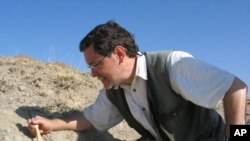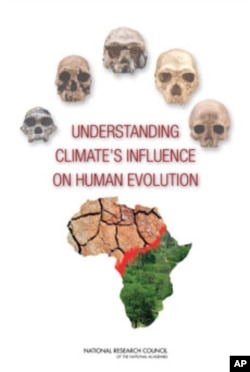Rick Potts tackles the mysteries of human origins for a living.
For over 25 years, the paleo-anthropologist at the Smithsonian Institution in Washington has led expeditions to East Africa to explore how our early ancestors adapted to changes in landscape and climate.
"You walk up a hillside of this eroded region of southern Kenya and you see layer after layer that indicates a huge lake was here, but then the lake is gone," says Potts. "Then there's a volcanic eruption that covered over all the grass. Animals had to move away. Then there's a river that came through that area. The lake is back and then there's a big drought, on and on, layer after layer — amazing chapters in this story of climate change."
Climate and evolution
Potts says prehistoric climate changes appear to have coincided with milestones in human evolution, such as the emergence of bipedalism — walking on two feet — the development of a larger brain and tool-making skills.
"What we were able to investigate is how those tool makers, using stone hand-axes for hundreds of thousands of years were able to adjust. But then the environmental changes got ramped up, and the hand axes disappear, and we see the technologies that are smaller," he says. "We have stone points that were attached to arrows that allowed our direct ancestors, right before the emergence of our own species, to hunt animals and do many more diverse things."
Search for answers
That link between climate and human evolution is the subject of a new National Research Council study.
Andrew Hill is professor of anthropology at Yale University and part of the team of scientists that contributed to the report. He says efforts to better understand the link between climate and evolution — and to more clearly define those evolutionary adaptations — are limited by gaps in the fossil record.
"Any time you find something, it's likely that there's some before that you haven't found yet, and so you're not really dating the origin of these things precisely," says Hill. "That gets better if you find more stuff. The bigger the size, the more likely you are to have an accurate first-appearance of a new behavior. And that's where we are deficient at the moment and why we need to explore more."
High-tech exploration
Hill says the research team recommends a major new effort to locate additional sites. And he notes that remote-sensing devices aboard satellites and unmanned aircraft can help to more precisely target where to excavate.
"You can actually search for different types of rock because different types of rock give off different types of signal in the non-visible part of the spectrum. And so you can look for sedimentary rocks as opposed to volcanic rocks and different kinds of rocks like lake beds where there might be something plausible."
Hill says the NRC report also recommends more extensive drilling to extract sediment cores from dry land, lake beds and ocean floors in regions where humans evolved. "In doing that you are also finding more specimens of other kinds of animals and archeology."
And, Hill adds, computer-generated climate models using data on temperature, precipitation and vegetation near human fossils can be a huge help not only in reconstructing past environments, but in understanding the science of climate change in our own era. "A very concrete way in which it's useful is that when you are working out models for what will happen in the future, the only way in which you can really test it, is by applying the models to the past where you know what really happened from other signals."
Family tree
Over at the Museum of Natural History in Washington Rick Potts is curator of a new exhibit on human origins.
He is also a contributor to the NRC report, which he says recommends new education programs to build on already-strong public interest in the science of human origins.
"The idea of being able to trace the emergence of our own species' resilience as the last remaining member of a diverse family tree, and how that evolutionary history interacts with the possibilities of the future, I think are extremely relevant, bringing together these two enormous areas of public curiosity, climate change and human evolution."
Potts says fossil and climate records can bring us a little closer to answering two fundamental questions: What does it mean to be human? And how will our resilient species adapt to a future of changing climate?










